2014 HYUNDAI COUPE warning
[x] Cancel search: warningPage 44 of 546
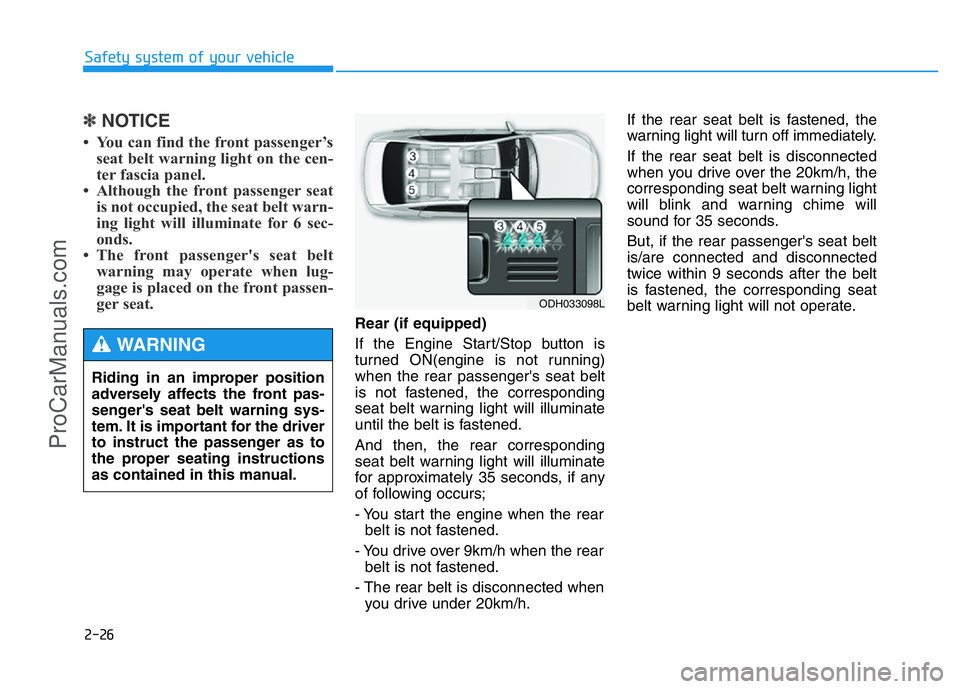
2-26
Safety system of your vehicle
✽NOTICE
• You can find the front passenger’s
seat belt warning light on the cen-
ter fascia panel.
• Although the front passenger seat
is not occupied, the seat belt warn-
ing light will illuminate for 6 sec-
onds.
• The front passenger's seat belt
warning may operate when lug-
gage is placed on the front passen-
ger seat.
Rear (if equipped)
If the Engine Start/Stop button is
turned ON(engine is not running)
when the rear passenger's seat belt
is not fastened, the corresponding
seat belt warning light will illuminate
until the belt is fastened.
And then, the rear corresponding
seat belt warning light will illuminate
for approximately 35 seconds, if any
of following occurs;
- You start the engine when the rear
belt is not fastened.
- You drive over 9km/h when the rear
belt is not fastened.
- The rear belt is disconnected when
you drive under 20km/h.If the rear seat belt is fastened, the
warning light will turn off immediately.
If the rear seat belt is disconnected
when you drive over the 20km/h, the
corresponding seat belt warning light
will blink and warning chime will
sound for 35 seconds.
But, if the rear passenger's seat belt
is/are connected and disconnected
twice within 9 seconds after the belt
is fastened, the corresponding seat
belt warning light will not operate.
Riding in an improper position
adversely affects the front pas-
senger's seat belt warning sys-
tem. It is important for the driver
to instruct the passenger as to
the proper seating instructions
as contained in this manual.
WARNING
ODH033098L
ProCarManuals.com
Page 46 of 546
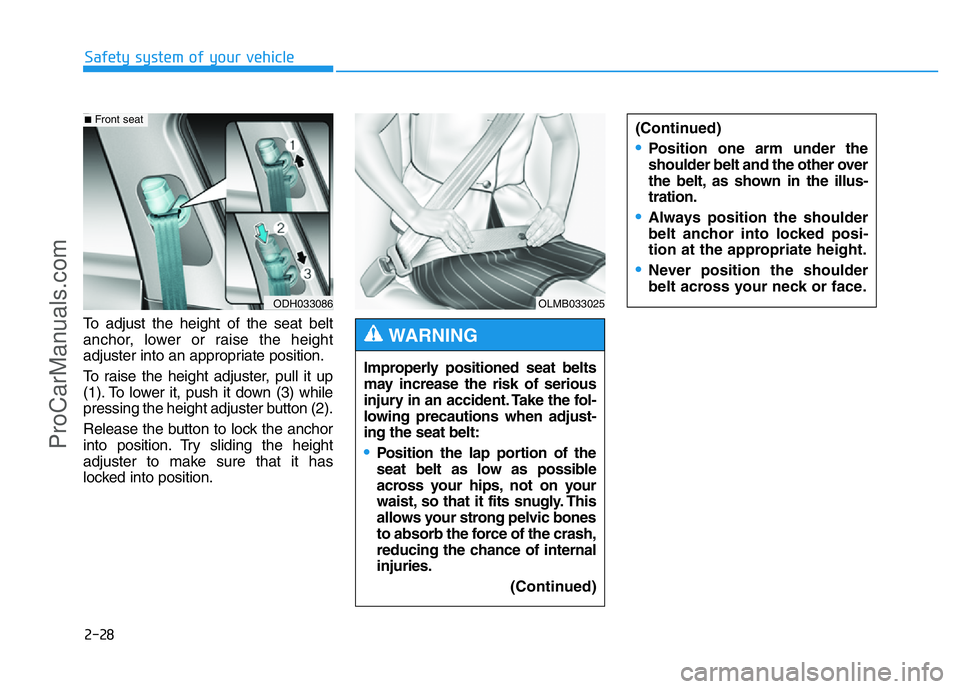
2-28
Safety system of your vehicle
(Continued)
•Position one arm under the
shoulder belt and the other over
the belt, as shown in the illus-
tration.
•Always position the shoulder
belt anchor into locked posi-
tion at the appropriate height.
•Never position the shoulder
belt across your neck or face.
To adjust the height of the seat belt
anchor, lower or raise the height
adjuster into an appropriate position.
To raise the height adjuster, pull it up
(1). To lower it, push it down (3) while
pressing the height adjuster button (2).
Release the button to lock the anchor
into position. Try sliding the height
adjuster to make sure that it has
locked into position.
ODH033086
■Front seat
OLMB033025
Improperly positioned seat belts
may increase the risk of serious
injury in an accident. Take the fol-
lowing precautions when adjust-
ing the seat belt:
•Position the lap portion of the
seat belt as low as possible
across your hips, not on your
waist, so that it fits snugly. This
allows your strong pelvic bones
to absorb the force of the crash,
reducing the chance of internal
injuries.
(Continued)
WARNING
ProCarManuals.com
Page 48 of 546
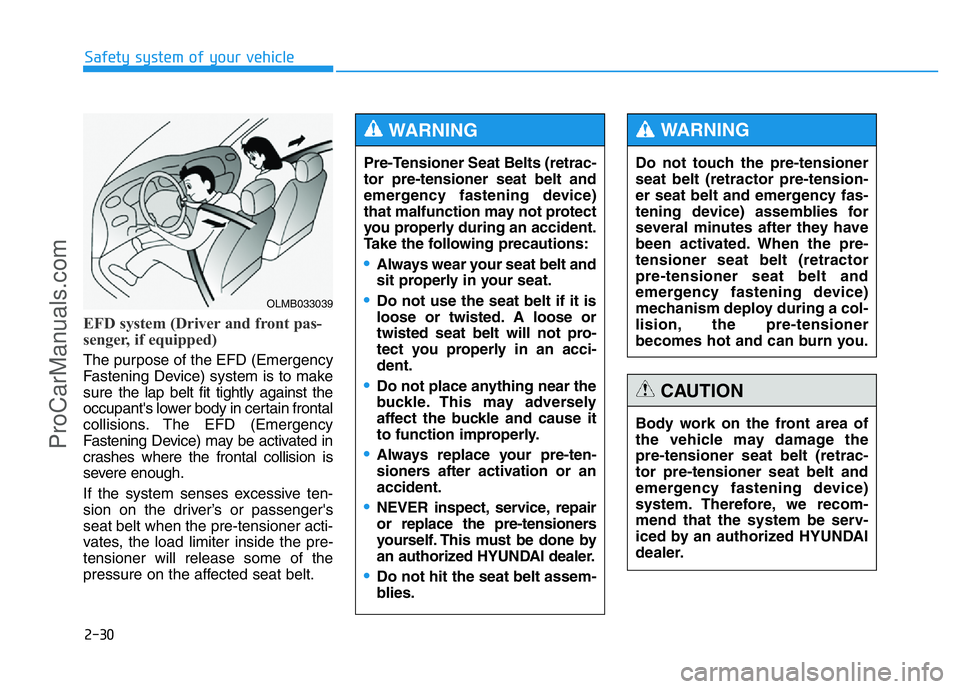
2-30
Safety system of your vehicle
EFD system (Driver and front pas-
senger, if equipped)
The purpose of the EFD (Emergency
Fastening Device) system is to make
sure the lap belt fit tightly against the
occupant's lower body in certain frontal
collisions. The EFD (Emergency
Fastening Device) may be activated in
crashes where the frontal collision is
severe enough.
If the system senses excessive ten-
sion on the driver’s or passenger's
seat belt when the pre-tensioner acti-
vates, the load limiter inside the pre-
tensioner will release some of the
pressure on the affected seat belt.Pre-Tensioner Seat Belts (retrac-
tor pre-tensioner seat belt and
emergency fastening device)
that malfunction may not protect
you properly during an accident.
Take the following precautions:
•Always wear your seat belt and
sit properly in your seat.
•Do not use the seat belt if it is
loose or twisted. A loose or
twisted seat belt will not pro-
tect you properly in an acci-
dent.
•Do not place anything near the
buckle. This may adversely
affect the buckle and cause it
to function improperly.
•Always replace your pre-ten-
sioners after activation or an
accident.
•NEVER inspect, service, repair
or replace the pre-tensioners
yourself. This must be done by
an authorized HYUNDAI dealer.
•Do not hit the seat belt assem-
blies.
WARNING
Do not touch the pre-tensioner
seat belt (retractor pre-tension-
er seat belt and emergency fas-
tening device) assemblies for
several minutes after they have
been activated. When the pre-
tensioner seat belt (retractor
pre-tensioner seat belt and
emergency fastening device)
mechanism deploy during a col-
lision, the pre-tensioner
becomes hot and can burn you.
WARNING
Body work on the front area of
the vehicle may damage the
pre-tensioner seat belt (retrac-
tor pre-tensioner seat belt and
emergency fastening device)
system. Therefore, we recom-
mend that the system be serv-
iced by an authorized HYUNDAI
dealer.
CAUTION
OLMB033039
ProCarManuals.com
Page 49 of 546
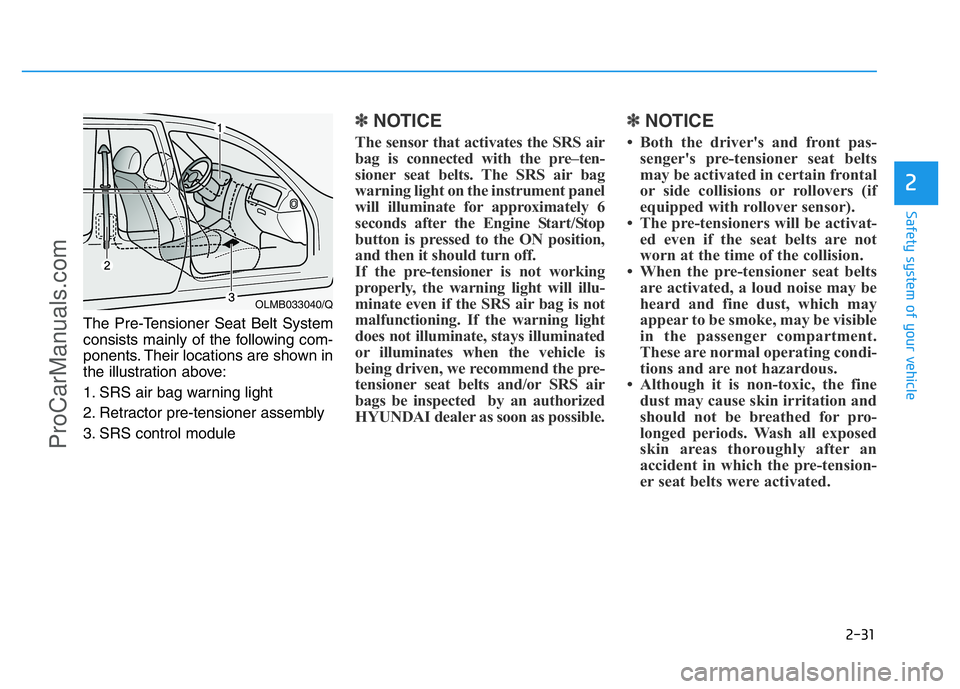
2-31
Safety system of your vehicle
2
The Pre-Tensioner Seat Belt System
consists mainly of the following com-
ponents. Their locations are shown in
the illustration above:
1. SRS air bag warning light
2. Retractor pre-tensioner assembly
3. SRS control module
✽NOTICE
The sensor that activates the SRS air
bag is connected with the pre–ten-
sioner seat belts. The SRS air bag
warning light on the instrument panel
will illuminate for approximately 6
seconds after the Engine Start/Stop
button is pressed to the ON position,
and then it should turn off.
If the pre-tensioner is not working
properly, the warning light will illu-
minate even if the SRS air bag is not
malfunctioning. If the warning light
does not illuminate, stays illuminated
or illuminates when the vehicle is
being driven, we recommend the pre-
tensioner seat belts and/or SRS air
bags be inspected by an authorized
HYUNDAI dealer as soon as possible.
✽NOTICE
• Both the driver's and front pas-
senger's pre-tensioner seat belts
may be activated in certain frontal
or side collisions or rollovers (if
equipped with rollover sensor).
• The pre-tensioners will be activat-
ed even if the seat belts are not
worn at the time of the collision.
• When the pre-tensioner seat belts
are activated, a loud noise may be
heard and fine dust, which may
appear to be smoke, may be visible
in the passenger compartment.
These are normal operating condi-
tions and are not hazardous.
• Although it is non-toxic, the fine
dust may cause skin irritation and
should not be breathed for pro-
longed periods. Wash all exposed
skin areas thoroughly after an
accident in which the pre-tension-
er seat belts were activated.
OLMB033040/Q
ProCarManuals.com
Page 50 of 546
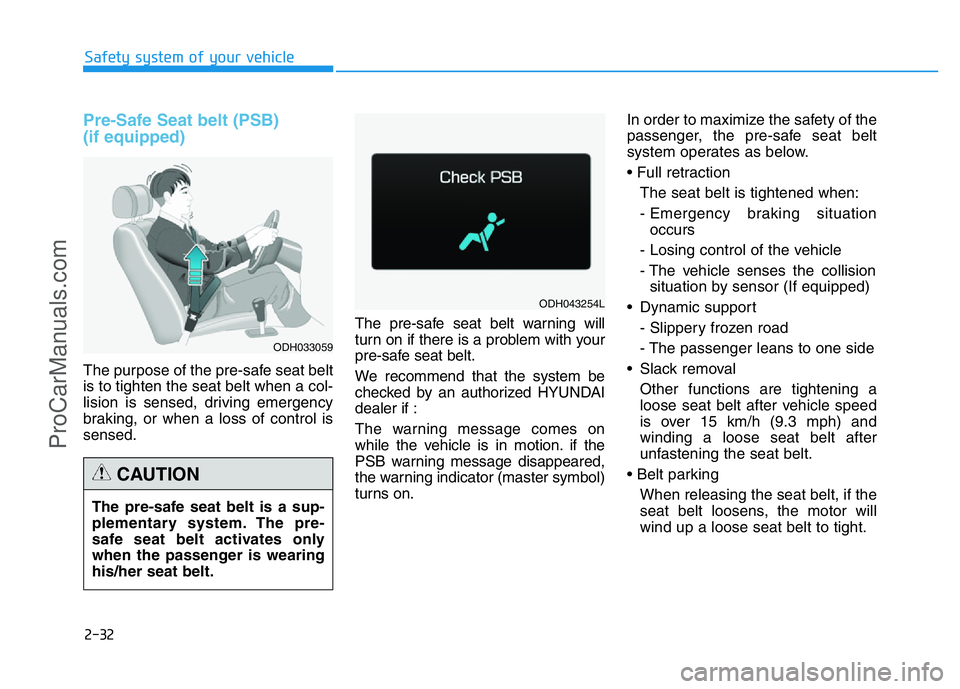
2-32
Safety system of your vehicle
Pre-Safe Seat belt (PSB)
(if equipped)
The purpose of the pre-safe seat belt
is to tighten the seat belt when a col-
lision is sensed, driving emergency
braking, or when a loss of control is
sensed.The pre-safe seat belt warning will
turn on if there is a problem with your
pre-safe seat belt.
We recommend that the system be
checked by an authorized HYUNDAI
dealer if :
The warning message comes on
while the vehicle is in motion. if the
PSB warning message disappeared,
the warning indicator (master symbol)
turns on.In order to maximize the safety of the
passenger, the pre-safe seat belt
system operates as below.
• Full retraction
The seat belt is tightened when:
- Emergency braking situation
occurs
- Losing control of the vehicle
- The vehicle senses the collision
situation by sensor (If equipped)
• Dynamic support
- Slippery frozen road
- The passenger leans to one side
• Slack removal
Other functions are tightening a
loose seat belt after vehicle speed
is over 15 km/h (9.3 mph) and
winding a loose seat belt after
unfastening the seat belt.
• Belt parking
When releasing the seat belt, if the
seat belt loosens, the motor will
wind up a loose seat belt to tight.
ODH033059
ODH043254L
The pre-safe seat belt is a sup-
plementary system. The pre-
safe seat belt activates only
when the passenger is wearing
his/her seat belt.
CAUTION
ProCarManuals.com
Page 51 of 546
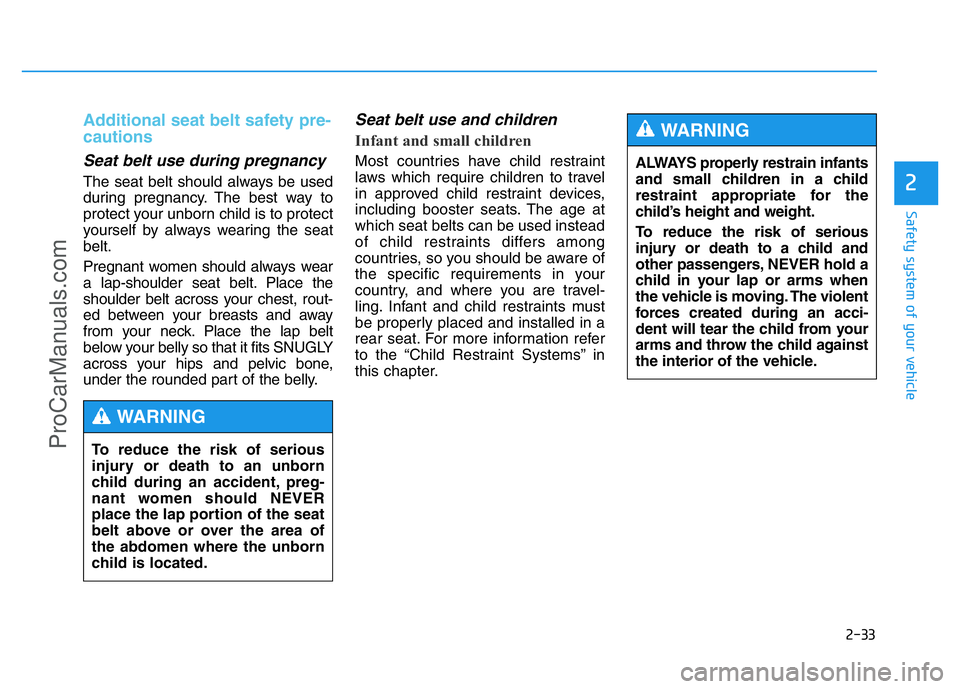
2-33
Safety system of your vehicle
2
Additional seat belt safety pre-
cautions
Seat belt use during pregnancy
The seat belt should always be used
during pregnancy. The best way to
protect your unborn child is to protect
yourself by always wearing the seat
belt.
Pregnant women should always wear
a lap-shoulder seat belt. Place the
shoulder belt across your chest, rout-
ed between your breasts and away
from your neck. Place the lap belt
below your belly so that it fits SNUGLY
across your hips and pelvic bone,
under the rounded part of the belly.
Seat belt use and children
Infant and small children
Most countries have child restraint
laws which require children to travel
in approved child restraint devices,
including booster seats. The age at
which seat belts can be used instead
of child restraints differs among
countries, so you should be aware of
the specific requirements in your
country, and where you are travel-
ling. Infant and child restraints must
be properly placed and installed in a
rear seat. For more information refer
to the “Child Restraint Systems” in
this chapter.
To reduce the risk of serious
injury or death to an unborn
child during an accident, preg-
nant women should NEVER
place the lap portion of the seat
belt above or over the area of
the abdomen where the unborn
child is located.
WARNING
ALWAYS properly restrain infants
and small children in a child
restraint appropriate for the
child’s height and weight.
To reduce the risk of serious
injury or death to a child and
other passengers, NEVER hold a
child in your lap or arms when
the vehicle is moving. The violent
forces created during an acci-
dent will tear the child from your
arms and throw the child against
the interior of the vehicle.
WARNING
ProCarManuals.com
Page 52 of 546
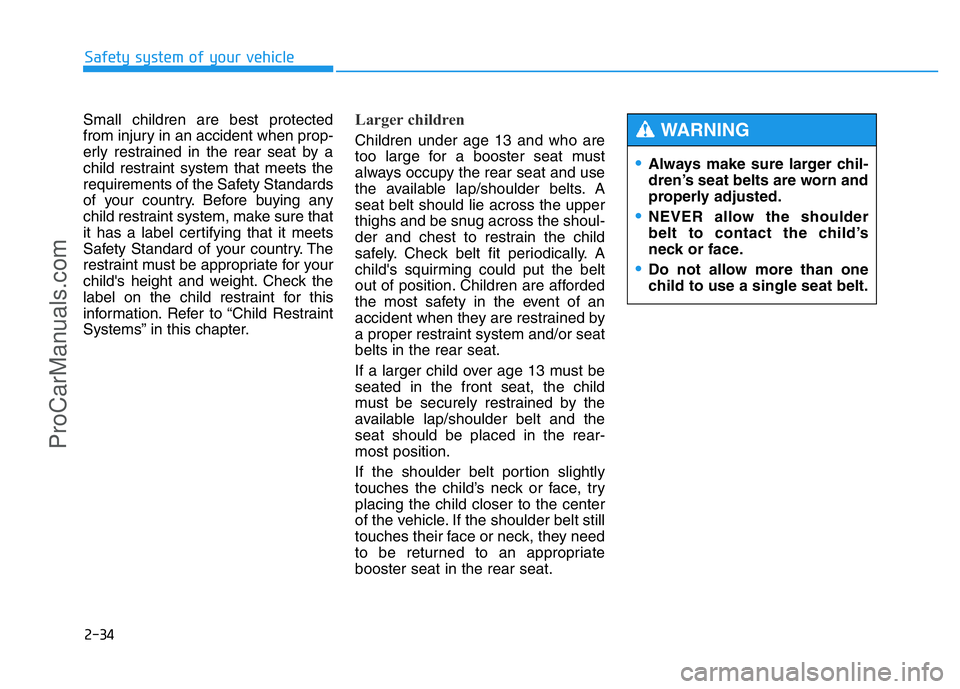
2-34
Safety system of your vehicle
Small children are best protected
from injury in an accident when prop-
erly restrained in the rear seat by a
child restraint system that meets the
requirements of the Safety Standards
of your country. Before buying any
child restraint system, make sure that
it has a label certifying that it meets
Safety Standard of your country. The
restraint must be appropriate for your
child's height and weight. Check the
label on the child restraint for this
information. Refer to “Child Restraint
Systems” in this chapter.
Larger children
Children under age 13 and who are
too large for a booster seat must
always occupy the rear seat and use
the available lap/shoulder belts. A
seat belt should lie across the upper
thighs and be snug across the shoul-
der and chest to restrain the child
safely. Check belt fit periodically. A
child's squirming could put the belt
out of position. Children are afforded
the most safety in the event of an
accident when they are restrained by
a proper restraint system and/or seat
belts in the rear seat.
If a larger child over age 13 must be
seated in the front seat, the child
must be securely restrained by the
available lap/shoulder belt and the
seat should be placed in the rear-
most position.
If the shoulder belt portion slightly
touches the child’s neck or face, try
placing the child closer to the center
of the vehicle. If the shoulder belt still
touches their face or neck, they need
to be returned to an appropriate
booster seat in the rear seat.
•Always make sure larger chil-
dren’s seat belts are worn and
properly adjusted.
•NEVER allow the shoulder
belt to contact the child’s
neck or face.
•Do not allow more than one
child to use a single seat belt.
WARNING
ProCarManuals.com
Page 53 of 546
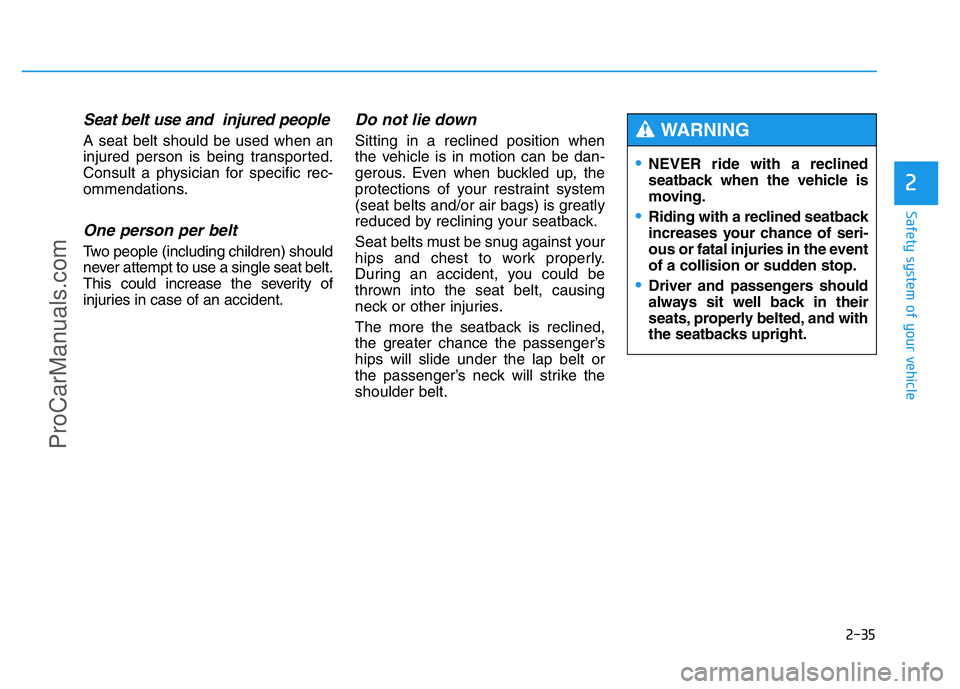
2-35
Safety system of your vehicle
2
Seat belt use and injured people
A seat belt should be used when an
injured person is being transported.
Consult a physician for specific rec-
ommendations.
One person per belt
Two people (including children) should
never attempt to use a single seat belt.
This could increase the severity of
injuries in case of an accident.
Do not lie down
Sitting in a reclined position when
the vehicle is in motion can be dan-
gerous. Even when buckled up, the
protections of your restraint system
(seat belts and/or air bags) is greatly
reduced by reclining your seatback.
Seat belts must be snug against your
hips and chest to work properly.
During an accident, you could be
thrown into the seat belt, causing
neck or other injuries.
The more the seatback is reclined,
the greater chance the passenger’s
hips will slide under the lap belt or
the passenger’s neck will strike the
shoulder belt.
•NEVER ride with a reclined
seatback when the vehicle is
moving.
•Riding with a reclined seatback
increases your chance of seri-
ous or fatal injuries in the event
of a collision or sudden stop.
•Driver and passengers should
always sit well back in their
seats, properly belted, and with
the seatbacks upright.
WARNING
ProCarManuals.com